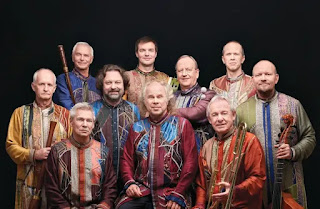 |
| Rotem Braten (flute), soprano Tali Ketzef (Elad Zagman) |
There was magic in the air in the Henry
Crown auditorium of the Jerusalem Theatre on March 15th 2022 as people arrived
to attend the gala evening celebrating the Jerusalem Opera's 10th
anniversary. Presenting opera choruses and arias were local and Israeli-trained
opera singers with the Jerusalem Symphony Orchestra, conducted by Omer Arieli,
the Jerusalem Opera's musical director. Master of ceremonies was Yair Haidu,
who has done the honours since the opera's first gala evening in 2012; his
father, Prof. Andre Hajdu, was one of the visionaries and initiators of the
Jerusalem Opera. Welcoming the audience and thanking all the people and
organizations for making the Jerusalem Opera a reality was Jerusalem deputy
mayor Yosi Havilio.
Opening the evening's musical program
and marking the 180th anniversary of the premiere of Giuseppe Verdi's
"Nabucco", Omer Arieli led the JSO in a fresh, contrasted and
exhilarating performance of the overture, one
consisting of themes from the opera, including that of the Chorus of
Hebrew Slaves, as well as the depiction of the Israelites' curse on Ismaele for
his betrayal. Then, two arias from Verdi's "Il trovatore" - Leonora's
Aria sung with delicacy, expressiveness and fine vocal control by soprano Mima
Millo, followed by the Gypsy Aria, into which mezzo soprano Noa Hope infused
strong, saucy gypsy presence, as she and Arieli brought its vibrant dance
rhythms to the stage. In the Slander Aria from Rossini's "Barber of
Seville", bass-baritone Vladimir Braun, one of Israel's major, long-established
opera singers, addressed each word and syllable, articulately explaining the
source and nature of slander with the wink of an eye, as the orchestra endorsed
his every word. Then to baritone Oded Reich's exuberant performance of the
Toreador Song from Bizet's "Carmen", an aria celebratory in
character, in which the arrogant toreador Escamillo describes various
situations in the bullring, the cheering of the crowds and the fame that comes
with victory. The stringent vocal and theatrical challenges of the Mad Scene
from Donizetti's "Lucia di Lammermoor" were met admirably by soprano
Tali Ketzef, wielding the coloratura as a vehicle of dramatic expression. Kudos
to Rotem Braten for her sensitive, attentive rendering of the Mad Scene's flute
obbligato, literally accompanying Lucia's descent through agony and delusion to
death. On a happier note was Song to the Moon from "Russalka"
(Dvořák), arguably one of the most beautiful arias ever written for the
soprano voice, with Olga Senderskaya’s honeyed, mellow vocal colours and
appealing stage presence rendering the aria a study in subtle shadings and deep
feeling.
Then to the evening's
opera choruses - from Rimsky-Korsakov's "The Tsar's Bride", the Marfa’s
Aria was sung delicately and with delightful shaping by soprano Yekaterina
Chepeleva, this followed by a quartet (Braun, Chepeleva, Hope, Stas Davidov);
Millo, Ketzef and Hope addressed the complex melodic weave and individuality of
roles in a trio from "Der Rosenkavalier" (Richard Strauss); and, with
much good cheer, all the singers joined to perform the Champagne Chorus from
"Die Fledermaus" (Johann Strauss II). Returning to
"Nabucco", the festive, sparkling event signed out with a more
thoughtful item - the Chorus of the Hebrew Slaves, the performance of it
dedicated to the Ukrainian refugees. Once again, as in the Jerusalem Opera's
productions over the past ten years, Maestro Omer Arieli's in-depth, dedicated guidance
and direction of singers and orchestra transported the audience into the
joyful, gripping, turbulent and alluring world of opera.

Oded Reich,Vladimir Braun,Olga Senderskaya (Elad Zagman)



